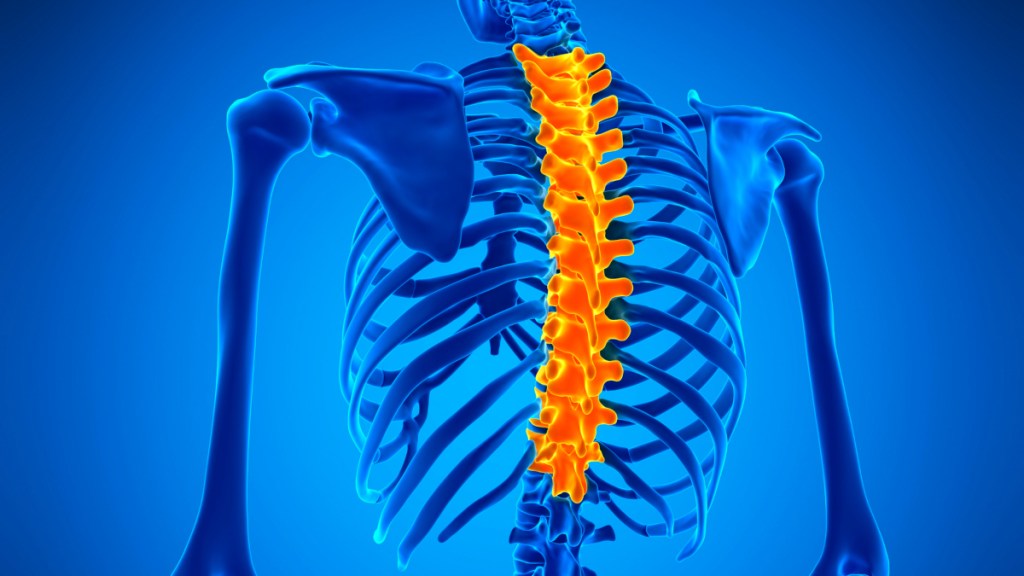Starting Your Day With This One Simple Move Thwarts Upper Back Pain, Doctor Says
Plus find out how gathering up your old books helps keep backaches at bay

We’ve all been there. You’re stuck in traffic leaning over the steering wheel, or maybe you’re hunched over your smartphone while scrolling through social media posts, when you start to feel an ache in your upper back. Often associated with poor posture, upper back pain between shoulder blades can get worse over time. But it doesn’t have to! We asked experts to weigh in on the top causes of this type of backache, plus share their best remedies for easing pain fast.
Understanding upper back pain between shoulder blades
When we talk about this part of the back, we typically mean the thoracic spine. That’s the area between the cervical spine (the neck) and the lumbar spine, or lower back. While pain is less common here than in other areas of the back, it still affects upwards of 20% of people at some point in their lives.
What’s tricky is that upper back pain between the shoulder blades could be originating from the thoracic spine. Or it could be radiating down from the lower neck — what’s called referred pain, explains DJ Kennedy, MD, Professor and Chair of the Department of Physical Medicine & Rehabilitation at Vanderbilt University in Nashville and president of the American Academy of Physical Medicine and Rehabilitation.

Top causes of upper back pain between shoulder blades
“If patients are coming in with symptoms that radiate down the arm or into the arm and to the shoulder blades, then sometimes we suspect pinched nerves in the cervical spine,” explains Leia Rispoli, MD, a physiatrist and interventional pain management specialist at DISC Sports & Spine Center in Newport Beach and Marina del Ray, California. “This can also cause some symptoms that feel like pain within the shoulder blades, even if it’s not directly related to pathology within those muscles.”
Another common trigger of upper back pain between the shoulder blades: poor posture. “Those muscles are typically most strained by poor posture — we call it exaggerated kyphosis of the thoracic spine — and always looking down at a phone or a table with a computer screen,” Dr. Rispoli says. “It’s super common and mostly easily treated with physical therapy and postural habitual techniques that are corrected.” (Click through to see how to get rid of a neck hump, also known as kyphosis.)
Arthritis or disc problems can also trigger back pain. As Dr. Kennedy notes, women generally have less bone mineral density than men as they age. This puts us more at risk for fractures in the spine, which can contribute to upper back pain between the shoulder blades.
What’s more, “women tend to have a little bit more of a difficulty keeping that balance of strong anterior and posterior muscles,” says Dr. Rispoli. “Especially women that have had babies, that have had core destruction through carrying a baby and labor and possible C-sections. We tend to have little bit harder of a hurdle to regain good quality core strength and spine strength.”

What upper back pain between shoulder blades feels like
How upper back pain between the shoulder blades feels can vary depending on the cause. The pain from a pinched nerve could feel sharp, says Dr. Rispoli. But if you move a chair and suddenly feel excruciating, 10-out-of-10 level pain, that may be consistent with a compression fracture, says Dr. Kennedy.
“Patients that feel more like the dull muscle tightness, spasm and discomfort throughout, I’d say more likely has just poor spine mechanics and posture and just muscle strain from supporting the poor posture,” explains Dr. Rispoli.
You may find this type of aching pain can progress over time, too. For example, say you’re working on your computer. At first, you may only feel pain at the very end of your work day. But as time goes on, you’re in pain at 2 pm, then 11 am. “To me, that’s a classic history for somebody that might benefit from an exercise-based regimen focused on ways to break up their day,” says Dr. Kennedy. That can include stretches or different moves to help you get into a better position.
How to soothe upper back pain between shoulder blades
Ready to find some relief? Here’s what our experts say can help.
1. Stand tall
Starting your day with proper posture sets you up for success. Why? We tend to lose proper alignment as the day goes on, which can trigger pain. Plus if you make correcting your posture one of the first things you do when you wake, it becomes a habit, says Dr. Rispoli. “Establishing a healthy habit is everything,” she adds. “Keeping good posture and spine mechanics is likely to help patients with upper back or even low back issues.”
Cuing up a quick yoga or pilates video is a great idea, Dr. Rispoli says. As is a morning wall stretch. “I like to tell patients to find a flat area of a wall,” she says. “Then line up your back and meet your shoulder blades and get them to be as flat as you can to the wall. Push your head back into the wall, too, so you’re not flexing your neck forward. Everything should be meeting in a neutral spot.” Hold for about 10 seconds.
Tip: If you ever feel like you’re starting to slouch or hunch throughout the day, you can do this wall stretch again, she notes. Check out the video below for more on this type of wall stretch.
2. Move your monitor
If you regularly use a computer, adjusting your set-up helps ensures proper posture. “When you get in good position, you want your eyes looking straight ahead to hit the middle of the monitor,” Dr. Kennedy advises. “You don’t want to have to look up and bend your head upwards, but you also shouldn’t be hunched over it.” Achieving this could be as simple as putting a few old books under your monitor to elevate it, he says.

3. Do a doorway stretch
Tend to spend long stretches of time seated? Us, too. To dodge upper back, Dr. Kennedy suggests setting reminders on your phone to get up and move. Simply popping into your kitchen to refill your coffee cup counts!
While you’re up, boost the benefit with a doorway stretch. It’s something Dr. Kennedy does multiple times a day. Just stand in a doorway and put your hands and forearms on the outer side of the doorframe, with one foot ahead. Lean in and hold for 30 seconds to help open up your chest. Check out the quick video below for a visual how-to.
4. Try the ‘Gokhale Method’
“I’ve used the Gokhale Method before personally and I refer patients to it, too,” says Dr. Kennedy. It involves improving your posture with various stretches and techniques. “I like it because the goal is to have your spine in ideal alignment as much as possible — while sitting, standing, walking and so on,” says Dr. Kennedy.
“By focusing on posture, one can hopefully achieve ideal alignment,” he adds. “An analogy would be making sure your tires are aligned correctly on your car to prevent wear and tear on the tires.” To try it, check out some free workshops online. In them, you’ll learn things like the “stretchsit” technique, where you sit in such a way that it helps stretch your muscles and minimize pain.
5. Keep your muscles strong
“I really like strength training for my patients, too,” says Dr. Kennedy. He says that when it comes to back pain, strength training has some of the best research-backed evidence. In fact, a study in BMJ Open Sport & Exercise Medicine found that participants who did free weight training (such as standing rows and press-ups) for 16 weeks had less pain and better strength endurance.
For best results, he advises strength training at least two to three times per week. “The weight should be light enough that they can do at least 10 repetitions for 2-4 sets,” he says. “But it should also be heavy enough that they can’t easily do over 20 repetitions. That 10-20 rep range is what I generally recommend for women age 50-70.”

Bonus: Strength training can block future back pain troubles, too. “Given osteoporosis and compression fractures are a bigger risk factor for women as they age, strength training is one of the best preventative mechanisms for that,” Dr. Kennedy says. (Click through to see what vitamin stops age-related muscle loss.)
6. Consider OTC meds
If your back pain is especially bothersome, you can take an over-the-counter pain medicine like Tylenol, an anti-inflammatory medicine like ibuprofen or even both in combination says Dr. Kennedy. But he cautions that it shouldn’t be taken long-term. “I generally tell people if they need them daily for more than a few weeks, then it’s time to think of something else,” he says. “There are some that argue medications shouldn’t be used. But I think for people that are strength training for health, moving throughout the day, working on flexibility and posture, who have intermittent pain that limits their ability to function, I think this is very reasonable.”
When to see a doctor
Dr. Rispoli says if you have weakness or numbness in your limbs, and/or if you’re experiencing daily pain and discomfort that isn’t responding to any of the treatments above, you should visit your doctor. And if you have a history of certain conditions like cancer, compression fractures or osteoporosis, call your provider, adds Dr. Kennedy.
For more ways to ease back pain naturally:
What Causes Mid Back Pain + the Easy Shoulder Squeeze That Makes It Go Away
How to Get Rid of a Neck Hump — And Soothe Neck and Back Pain in the Process
This content is not a substitute for professional medical advice or diagnosis. Always consult your physician before pursuing any treatment plan.


















